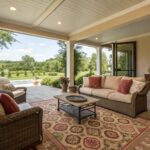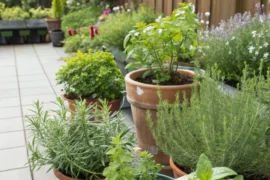When designing spaces that truly work for clients, I’ve found that understanding how materials interact with heat can make the difference between a space that’s comfortable year-round and one that’s abandoned during temperature extremes. Throughout my career creating interiors and gardens across varied climates, this knowledge has proven invaluable in creating spaces that don’t just look beautiful, but feel right regardless of season.
Understanding Heat Properties of Materials
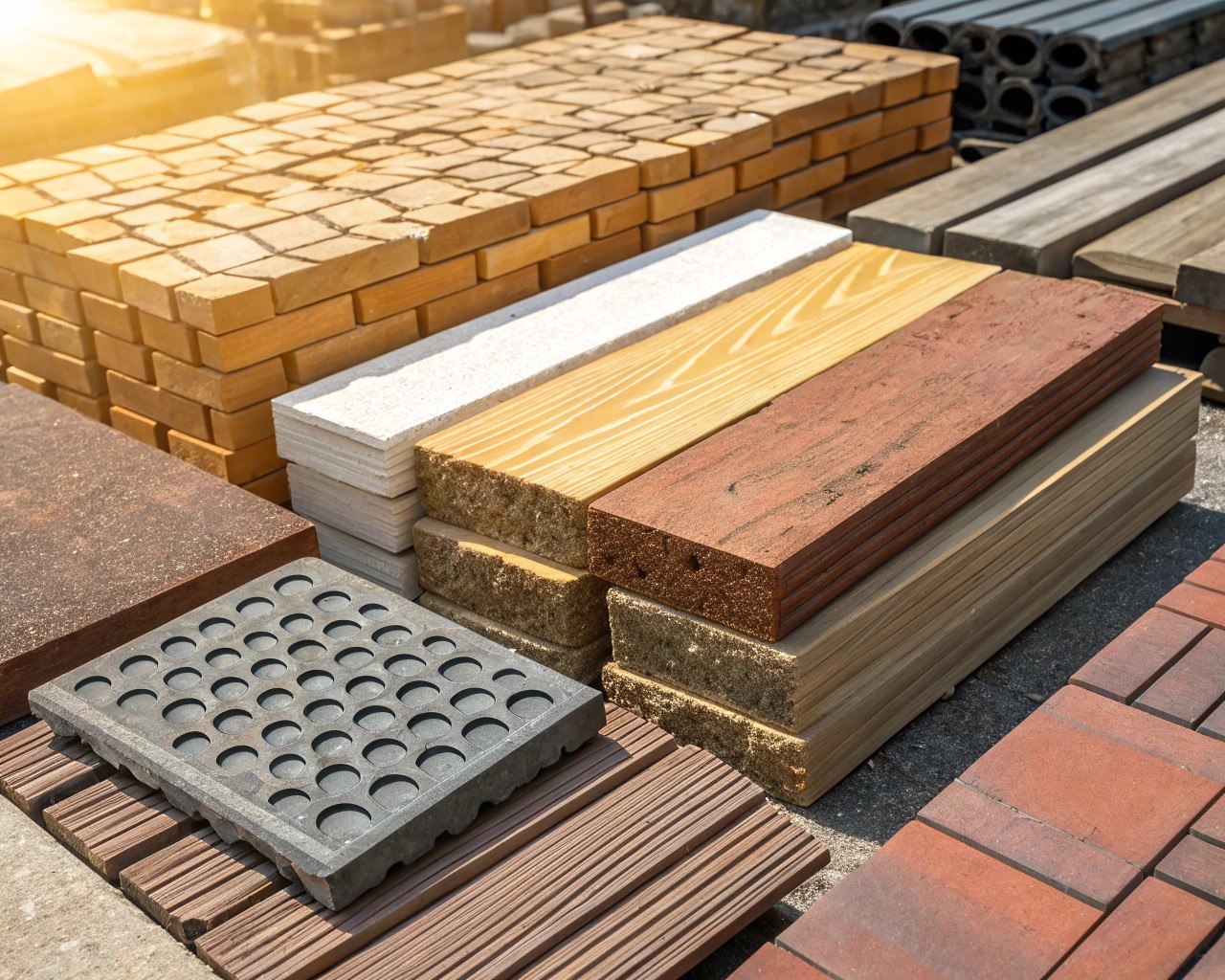
The way materials interact with heat fundamentally shapes how comfortable a space feels. There are three key properties we need to understand: thermal mass, heat reflection, and heat absorption.
Thermal Mass
Thermal mass refers to a material’s ability to absorb, store, and release heat over time. Materials with high thermal mass act like batteries for heat—charging up during warm periods and discharging when surroundings cool down.
My experience in residential projects indicates that clients sometimes misunderstand thermal mass, perhaps assuming heavy materials invariably make spaces hotter. The reality is more nuanced: properly utilized thermal mass promotes temperature stability, mitigating extremes.
Heat Reflection
Heat reflecting materials are designed to reflect radiant heat rather than absorbing it. These specialized materials, typically featuring highly reflective surfaces like aluminum foil or metallic coatings, can reflect up to 97% of radiant heat. This makes them particularly valuable in hot climates or sun-exposed locations.
Heat Absorption
Heat absorption describes how readily a material soaks up thermal energy. Dark, dense materials generally absorb more heat than light, porous ones. This property can be either beneficial or problematic depending on your climate and specific needs.
Comparative Heat Properties
Understanding how different materials interact with heat can guide your selection process:
| Material | Density (kg/m³) | Heat Capacity (kJ/kg·K) | Heat Reflection | Best Application |
|---|---|---|---|---|
| Granite | 2600 | 0.79 | Low | Temperature stability |
| Brick | 1920 | 0.84 | Low-Medium | Interior walls, features |
| Concrete | 2400 | 0.75 | Low-Medium | Flooring, hardscaping |
| Water | 1000 | 4.18 | Low | Cooling features |
| Aluminum | Low | Low | Very High (85-90%) | Radiant barriers |
| Wood | Varies | 1.76 | Medium | Moderate heat storage |
| Fiberglass | Low | Low | Medium-High | Insulation up to 500°C |
Interior Material Selection
The materials you choose for interior spaces dramatically impact both comfort and energy efficiency.
Flooring Options
Your flooring choice significantly affects how a space feels temperature-wise:
-
Stone and Tile: These materials have high thermal mass and can absorb and retain heat, releasing it slowly throughout the day. They’re excellent choices for passive solar design where they can absorb winter sunlight and release heat in the evening.
-
Wood: With moderate heat capacity, wood provides a comfortable middle ground that won’t get too hot or too cold, creating a naturally comfortable surface.
-
Carpeting: While providing insulation underfoot, carpeting has minimal thermal mass benefits. It’s better for spaces where consistent warmth is desired.
Wall Materials and Treatments
Wall surfaces play a crucial role in heat management:
-
Masonry Walls: Brick, stone, or concrete walls possess excellent thermal mass. In a recent project, we incorporated an exposed brick wall in a south-facing room that maintained remarkably stable temperatures despite large daily fluctuations outside.
-
Reflective Insulation: Specialized materials like Heat Reflect (fiberglass coated with aluminum foil) create effective barriers against radiant heat while withstanding higher operating temperatures compared to standard materials.
-
Paint Colors: While seemingly simple, color choice significantly impacts heat absorption. Mediterranean architecture traditionally features white walls specifically to reflect heat away from buildings.
Window Solutions
Windows are major sources of heat transfer:
-
Low-E Glass: Modern low-emissivity glazing has revolutionized energy efficiency by reducing heat transfer while maintaining visual clarity.
-
Thermal Curtains: Insulated curtains can be drawn at night to retain heat and opened during the day to allow beneficial sunlight.
-
Strategic Placement: In the northern hemisphere, south-facing windows receive the most direct sunlight, particularly valuable in winter when the sun is lower.
Case Study: The Sunroom Transformation
One of my favorite projects involved transforming an unusable Arizona sunroom that routinely reached 110°F during summer afternoons. We:
- Replaced standard glass with Low-E glazing
- Installed light-colored travertine flooring for its cooling properties
- Added reflective insulation in the ceiling cavity
- Created strategic cross-ventilation paths
The temperature dropped by an average of 12°F during peak heat, making the space usable year-round. This transformation allowed the clients to reclaim what had been essentially unusable square footage for eight months of the year, much to their satisfaction.
Exterior Material Selection

Outdoor spaces present unique challenges for heat management, requiring materials that balance aesthetics, durability, and thermal performance.
Garden Hardscaping
The materials you select for garden paths, patios, and walls significantly impact comfort:
-
Travertine: This natural stone doesn’t retain heat, remaining cool to touch even under direct sunlight. I’ve specified travertine for numerous desert gardens where clients can comfortably walk barefoot even on 100°F days.
-
Concrete: While concrete generally absorbs heat, lighter-colored varieties reflect more sunlight. Their thermal mass can be beneficial in moderating temperature extremes.
-
Porcelain Pavers: These offer excellent heat-resistance by reflecting sunlight rather than absorbing it, making them ideal for pool surrounds and dining areas.
Living Elements for Heat Management
Incorporating vegetation into your design naturally moderates temperature:
-
Trellised Vines: Plants like climbing roses or honeysuckle cool sun-exposed walls because they don’t absorb and release heat. A client’s western brick wall transformed from a heat radiator to a cooling element after installing crossvine on a simple trellis.
-
Green Walls: Living wall systems with herbs or ornamentals create naturally cooling surfaces through transpiration.
-
Water Features: Due to water’s exceptional heat capacity (4.18 kJ/kg·K compared to concrete’s 0.75), even small water elements provide significant cooling effects.
Heat Comparison of Patio Materials
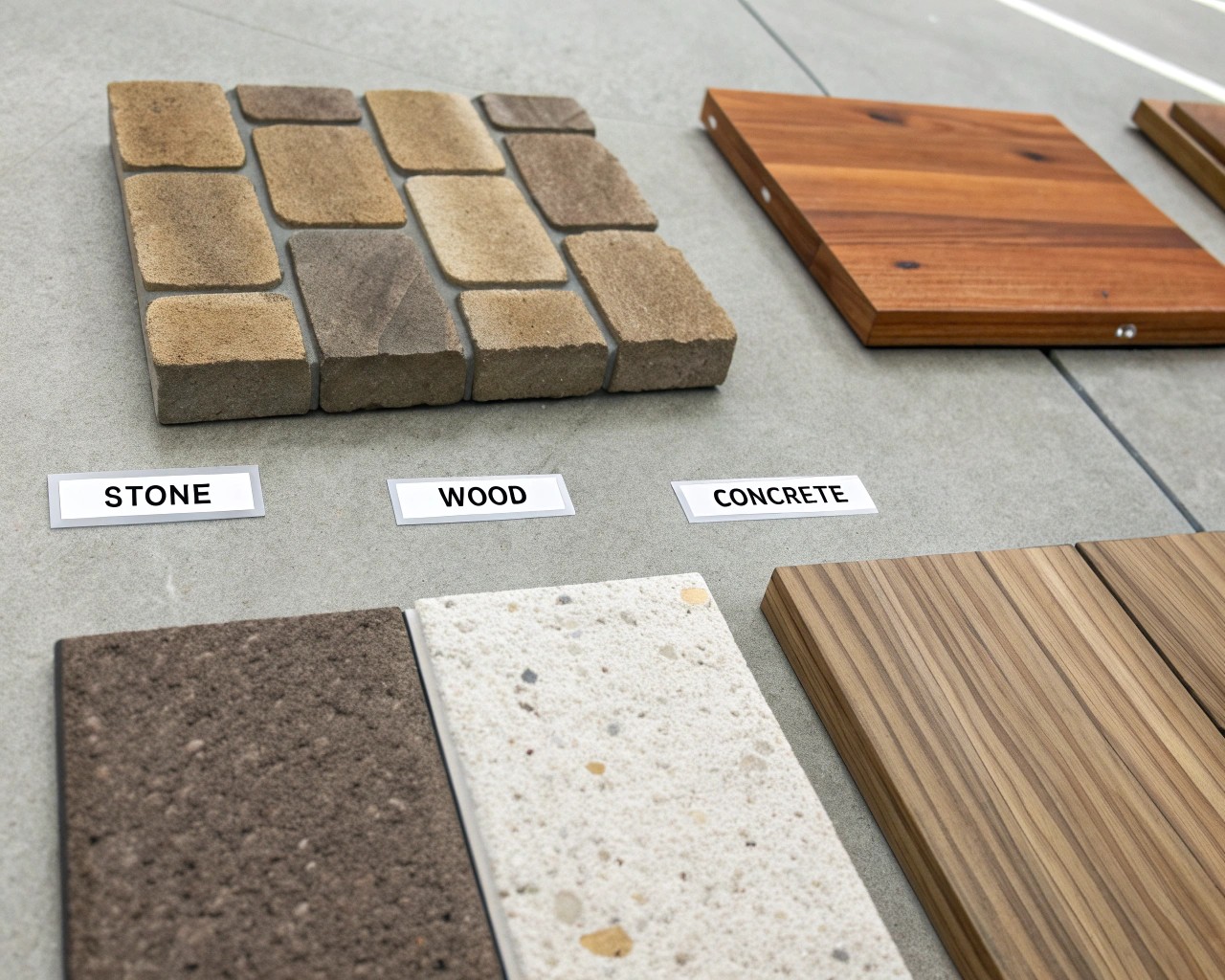
When selecting patio materials for hot climates, consider these comparative properties:
| Material | Heat Absorption | Comfort on Bare Feet | Maintenance | Cost Range |
|---|---|---|---|---|
| Concrete | High | Low | Low | $ |
| Pavers | Moderate-High | Moderate | Low-Moderate | $$ |
| Travertine | Low | High | Moderate | $$$ |
| Porcelain | Low-Moderate | High | Very Low | $$$ |
| Natural Stone | Variable | Variable | Moderate-High | $$$-$$$$ |
| Wood Decking | Moderate | Moderate | High | $$-$$$ |
Case Study: Desert Community Garden
A challenging project involved creating a functional outdoor gathering space for a retirement community in Phoenix. The existing dark concrete patio was unusable for much of the year due to extreme heat.
Our solution incorporated:
1. Light-colored travertine for primary seating areas
2. Pergolas with deciduous vines for seasonal shade
3. Living green walls along western exposures
4. Small water features for evaporative cooling
5. Strategic tree placement for morning/afternoon shade
Post-installation temperature measurements showed surface temperatures reduced by up to 30°F compared to the previous design. Feedback indicated that residents were subsequently able to use the space throughout much of the summer, whereas previously they had avoided it entirely after 10 AM.
Advanced Heat Management Techniques
Beyond basic material selection, more sophisticated techniques can dramatically improve thermal performance.
Passive Heating Systems
Passive heating relies on capturing and distributing solar energy without mechanical assistance:
-
Direct Solar Gain: South-facing windows with appropriate thermal mass flooring allow winter sun to warm spaces naturally.
-
Trombe Walls: These specialized walls consist of a sun-facing masonry wall with a glass exterior layer and an air gap between. They collect solar energy during the day and release it slowly at night.
-
Thermal Mass Placement: Strategic positioning of high thermal mass materials can capture winter sun while avoiding summer heat gain. In one mountain home renovation, we placed specific stone flooring elements to receive winter sunlight while remaining shaded in summer.
Reflective Systems
Reflective materials can dramatically reduce heat transfer:
-
Radiant Barriers: These highly reflective materials, typically aluminum-faced, reflect up to 97% of radiant heat. They’re particularly effective in attics and roof systems.
-
Heat-Reflective Coatings: Specialized paints and coatings can significantly increase surface solar reflectance. The difference can be substantial; for instance, measurements I’ve taken showed dark roofs reaching 160°F while identical reflective-coated roofs remained below 120°F on the same day.
Thermal Regulation Strategies
For comprehensive temperature control, consider these approaches:
-
Insulation Selection: Proper insulation helps prevent heat loss and keeps indoor spaces warmer for longer periods. Materials like cellulose, wool, or recycled denim offer excellent thermal performance.
-
Air Spaces: Creating strategic air spaces between materials can enhance insulating properties. In hot climates, ventilated air spaces between roofing and living spaces significantly reduce heat transfer.
-
Rooftop Gardens: Vegetation provides natural insulation, reducing heat absorption through building roofs. The soil and plants act as a barrier against direct sunlight.
Case Study: Commercial Building Retrofit
A commercial client approached us about their 1990s office building suffering from excessive heat gain and astronomical cooling costs. Rather than replacing the HVAC system, we implemented:
- A reflective roof coating to reduce absorption
- Strategic thermal mass elements in the atrium
- A rooftop garden with drought-resistant plants
- Interior living walls as natural cooling elements
- Low-E window films on east/west exposures
The intervention reduced summer cooling costs by 31% and significantly improved occupant comfort surveys. A key benefit noted by the client was that these changes extended the life of their existing HVAC system by reducing its workload.
Seasonal Considerations for Year-Round Comfort
One of the greatest challenges in material selection is balancing needs across seasons, especially in regions with significant temperature variations.
Balancing Winter and Summer Needs
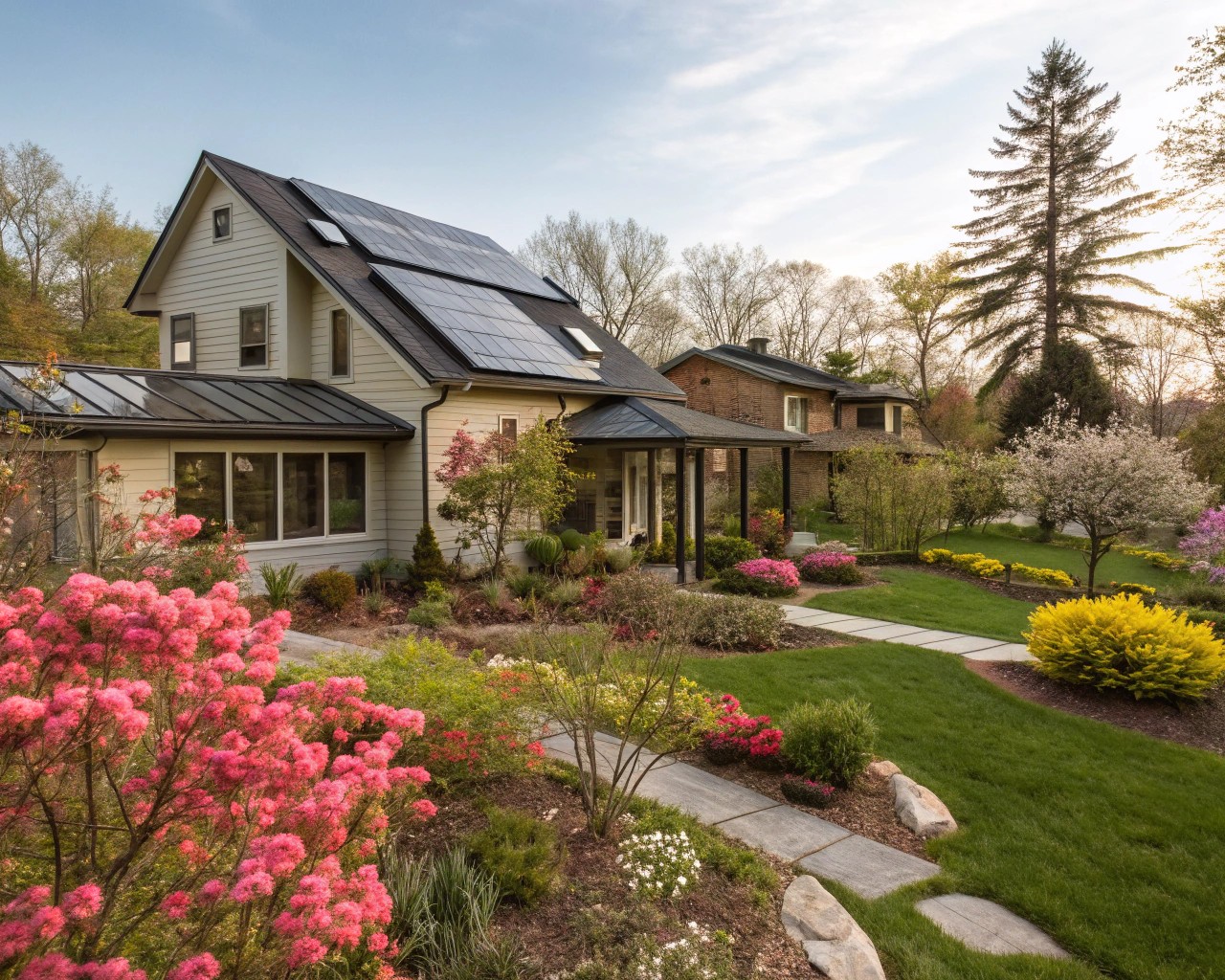
Materials often need to serve different purposes as seasons change:
-
Deciduous Vegetation: Nature provides an elegant model for seasonal adaptation. Deciduous plants shade in summer while allowing sunlight through in winter.
-
Adjustable Systems: Retractable awnings, operable louvers, and seasonal window treatments allow adaptation to changing conditions.
-
Multi-Functional Materials: Some materials can serve different seasonal purposes. For instance, a water feature that cools in summer can reflect valuable winter sunlight onto thermal mass elements.
Heat Management Throughout the Day
Consider how heat flows through your space over a 24-hour period:
-
Morning Optimization: East-facing areas benefit from materials that warm quickly in morning sun but don’t overheat.
-
Afternoon Protection: West-facing exposures need materials that reflect rather than absorb the intense afternoon sun.
-
Evening Release: Thermal mass that gradually releases stored heat can extend outdoor usability into evening hours.
Client Story: The Four-Season Garden
One of my most educational projects was designing a garden for a retired physics professor in a climate with extreme seasonal variations. She presented the challenge of creating an outdoor space that would be comfortable year-round without mechanical systems.
We created distinct zones:
1. A winter garden with reflective surfaces and dark stone that captured and retained heat
2. A summer relaxation area featuring light-colored travertine and water elements
3. Transitional spaces with adjustable shade structures
4. Strategic plantings that provided summer shade but allowed winter sun penetration
Five years later, she reports using the garden nearly 300 days each year—and has the temperature logs to prove it, showing a remarkable 15°F difference between summer and winter zones during extreme weather.
Practical Implementation Guide
You don’t need a complete renovation to improve heat management. Here are practical ways to incorporate these principles:
For Homeowners: Quick Wins
-
Window Treatments: Adding reflective window film to east/west windows or installing thermal curtains provides immediate benefits.
-
Strategic Paint: Light-colored, reflective exterior paint can significantly reduce heat absorption, especially on roofs and west-facing walls.
-
Temporary Shade: Seasonal shade sails or outdoor curtains can block direct sun while allowing airflow.
Material Selection Priorities
When you’re ready to make more substantial changes, prioritize these areas:
-
Roof and Attic: As your home’s primary solar exposure, improvements here yield significant benefits. Consider reflective roofing materials or coatings, and proper attic insulation.
-
West-Facing Walls and Windows: These receive the most intense afternoon sun. Prioritize reflective or high thermal mass materials here.
-
Outdoor Living Spaces: Select materials based on when you most use the space—cooling materials for summer use, heat-absorbing materials for spring/fall/winter use.
Budget-Conscious Approaches
Heat-conscious design doesn’t have to break the bank:
-
Phased Implementation: Start with high-impact areas and expand over time.
-
Strategic Placement: Even small amounts of premium materials can make a difference when placed thoughtfully. A small travertine seating area surrounded by less expensive materials can create a comfortable zone where it matters most.
-
Dual-Purpose Selections: Choose materials that provide multiple benefits. For example, a pergola that supports both shade vines and solar panels.




